Do you know of any other sailboat race where $10,000 in prize money is nailed to a tree on the finish line? Or an endurance race that can take anything from three days to two months to finish, with the boat coming second being awarded a consolation set of ten dollar steak knives?
All the intrepid sailor needs to do to claim their ten grand is race their sailboat seven hundred and fifty miles into the wilds of Alaska, through some of the world’s most treacherous seas and inland passages that are prone to whatever the weather rolling in from the Gulf of Alaska can throw at them. And, just as an aside, twelve knot riptide currents, complete with whirlpools and standing waves bar the way through narrow rapids and misty mountain channels. What’s more, the greatest concentration of hostile grizzly bears and hungry wolves prowl the shorelines, killer whales and ‘dead-head’ trees lurk all of the time in the exceptionally cold waters to remind intrepid racers that catastrophe is only ever moments away. Welcome to the Race to Alaska…
This two legged race that’s fast becoming the benchmark in tough endurance sailing, attracting both the best in international racers and those mad-head die-hards who believe they can beat the best. The rules are simple – no engines, no support and no rules. The route is the racer’s own choice but there are two waypoints that must be passed to avoid disqualification. The first is located in the Seymour Narrows, a treacherous waterway deep in the mountainous region of British Columbia’s Inside Passage and the second near Bella Bella, which keeps contestants vaguely together within a vast, wild and remote region where some measure of safety can be provided for those in genuine trouble. Large numbers of boats and their crews – from singlehanded die-hards to well trained racers, simply drop out from exhaustion or equipment failure to be rescued by the one single race organiser’s support vessel bringing up the rear. Oh… and if the support boat passes you, you are automatically disqualified. If a racer contests a race organiser’s judgement, and the contestant feels the need to consult a lawyer, then Rule 8 clearly states that consulting a lawyer constitutes automatic disqualification.
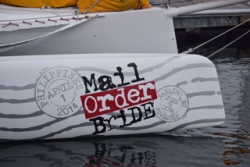 Then, there’s the boats. Many are self-built, adapted or borrowed – but not all. Professionally built trimarans, monohulls and catamarans, purpose designed for fast performance racing litter the field alongside incomprehensible rowboats retrofitted with masts and sails, those too mingling with single-handed dinghies, sailboards, fast windsurfers and even paddle-boards sporting hockey-stick style masts. There’s no handicap system either – this race is more about personal endurance, not the boat that’s invariably on show. The one thing every boat has in common, in addition to masts and sails, is a means of secondary propulsion to combat the rapids, the fierce currents, deep sheltered mountainous fjords with no wind and also the need to somehow manoeuvre into miserly approved harbours or craggy overnight anchorages if not racing through the night. These are usually oars – but increasingly ingenious paddle mechanisms commonly self-designed and fitted. In the UK, most of these boats would be found on inland lakes, inshore waters and the numerous weekend sailing clubs for hardy racers. In the UK, RYA safety recommendations would see most of these boats religiously restricted in their use…
Then, there’s the boats. Many are self-built, adapted or borrowed – but not all. Professionally built trimarans, monohulls and catamarans, purpose designed for fast performance racing litter the field alongside incomprehensible rowboats retrofitted with masts and sails, those too mingling with single-handed dinghies, sailboards, fast windsurfers and even paddle-boards sporting hockey-stick style masts. There’s no handicap system either – this race is more about personal endurance, not the boat that’s invariably on show. The one thing every boat has in common, in addition to masts and sails, is a means of secondary propulsion to combat the rapids, the fierce currents, deep sheltered mountainous fjords with no wind and also the need to somehow manoeuvre into miserly approved harbours or craggy overnight anchorages if not racing through the night. These are usually oars – but increasingly ingenious paddle mechanisms commonly self-designed and fitted. In the UK, most of these boats would be found on inland lakes, inshore waters and the numerous weekend sailing clubs for hardy racers. In the UK, RYA safety recommendations would see most of these boats religiously restricted in their use…
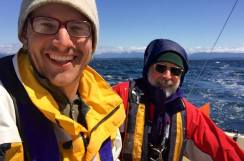 The Race To Alaska
The Race To Alaska
The R2AK race, founded by the Northwest Maritime Centre in Port Townsend, Washington State, begins in Port Townsend in the lower forty-eight States each June. It is definitely NOT a fun race, it’s a serious competition that’s quickly gaining credence with those in the know. The first leg, a mere forty mile ‘shakedown’ sail across the infamous Juan De Fuca Strait heads across the Canadian border to Victoria at the southern point of Vancouver Island. Here contestants undergo Canadian immigration and then begins the true endurance race, the seven hundred mile battle under sail northwards through truly wild and magnificent British Columbia, to the remote frontier border with Alaska to ring the bell at the finish line in Ketchikan. $10,000 is literally pinned to a tree but the race organisers also believe that coming second is a celebratory feat too. The crew coming in second are, almost as an afterthought, awarded a set of steak knives. There’s nothing for third place and those who finish sometime after, in fact, sometimes more than two months after.
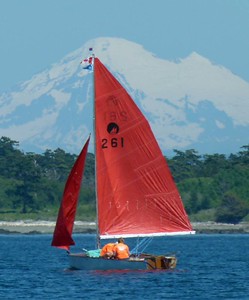 The philosophy of the race is best described by Jake Beattie, a founder of the R2AK and Executive Director of the Northwest Maritime Centre in Port Townsend, Washington State. “It’s as much a race as a celebration for the human spirit. It’s an opportunity for people to propel themselves into an adventure of a lifetime,” he declares, continuing to grasp for the right description, “This race is meant to be a recalibration of assumptions of what yacht racing is meant to be. It’s just the people and the coastline where nature is the arbiter of whether or not you’re doing a good job.” If you press Beattie further, a more basic philosophy arises, “I just hate rules in general, and yacht racing has so many rules,” he reflects.
The philosophy of the race is best described by Jake Beattie, a founder of the R2AK and Executive Director of the Northwest Maritime Centre in Port Townsend, Washington State. “It’s as much a race as a celebration for the human spirit. It’s an opportunity for people to propel themselves into an adventure of a lifetime,” he declares, continuing to grasp for the right description, “This race is meant to be a recalibration of assumptions of what yacht racing is meant to be. It’s just the people and the coastline where nature is the arbiter of whether or not you’re doing a good job.” If you press Beattie further, a more basic philosophy arises, “I just hate rules in general, and yacht racing has so many rules,” he reflects.
 The origins of the race are more profound with Beattie always keen to explain, “The idea crystallised at the 2014 Wooden Boat Festival in Port Townsend. There was a group of us sitting around in the beer garden and the conversation turned around how we could get people on the water without engines, with only sails.” They brainstormed the idea for a need for people of all types, not just the regatta crowd, to hit the water in an adventurous fashion. Beattie’s frustration with the highly structured world of traditional races was echoed by his co-conspirators, “The race is wild,” they too declared. “It is such a beautiful, rugged coastline that it will help connect people to nature and the water.”
The origins of the race are more profound with Beattie always keen to explain, “The idea crystallised at the 2014 Wooden Boat Festival in Port Townsend. There was a group of us sitting around in the beer garden and the conversation turned around how we could get people on the water without engines, with only sails.” They brainstormed the idea for a need for people of all types, not just the regatta crowd, to hit the water in an adventurous fashion. Beattie’s frustration with the highly structured world of traditional races was echoed by his co-conspirators, “The race is wild,” they too declared. “It is such a beautiful, rugged coastline that it will help connect people to nature and the water.”
In the R2AK’s inaugural year, 2015, thirty five boats turned up to begin the race with only fifteen reaching the finish line in distant Alaska. Word quickly spread. In 2016 entrants more than doubled to sixty five, some with dedicated racing crews and many single-handers – or simply two or three man crews looking for an experience of a lifetime. This year saw all women crews for the first time, competing their wits against their male counterparts without the encumbrance of handicaps or categories – one winner, one prize worth counting. Just like the 2015 race, incredible stories of endurance, mishaps and adventure begin to emerge…
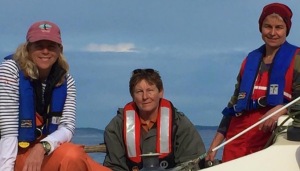 The Racers
The Racers
The racing catamarans and trimarans dominate. These are dedicated race teams with professionally rigged boats increasingly shipped from various parts of the world, often fresh from other racing events and keen to prove themselves in what is quickly becoming recognised on the grapevine as the race like no other race. The 2015 race was won by Elsie Piddock, a F-25c trimaran in a time of five days, one hour and fifty five minutes – two days and fourteen hours ahead of the next boat, Team MOB’s Mentality, a Farrier 28. The fifteenth and last boat to finish managed a magnificent twenty three days and five hours. Some crews simply abandoned to deliberately lose themselves in the beguiling wilderness, turning up in Ketchikan long after everyone had gone home. Three man crews proved to be the most successful, enabling two to race whilst the third slept. The winners came from the trimaran design of boat and was never really in doubt, but the true intrepid endurance came from those who came nowhere near and knew the steak knives were always out of their grasp, anchoring or tying up in sheltered indents in the shoreline, eating and drinking only what they could carry and taking every sneaky opportunity to overtake their opponents whilst they slept in exhaustion – only to be themselves driven back by fierce currents and gale force winds on the nose.
After witnessing the start of the 2016 race and keeping in touch with the rear boats in our own ocean going sailboat Sänna, we ourselves came alongside solo racer, Lite Boat, deep inside the infamous Johnstone Strait, number 56 on his bows, to ask if he needed water or food, “No, I’m just fine thanks,” he replied, “I’ve a roast joint with fresh potatoes in the oven which should be ready in about twenty minutes or so.” He then slyly pointed to racer number 46 tied to a tree on the shore, “and I want to get by him whilst he’s asleep.” There was no wind at this time, only a three knot current against which he was rowing. Of course, he had no oven, only bags of vacuum packed food eaten cold.
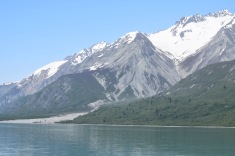 The Most Scenic Sail Race in the World
The Most Scenic Sail Race in the World
The racers quickly string out. The Inside Passage funnels up the eastern side of Vancouver Island with Vancouver itself a distant glimmer to the eastern mainland. The route from Victoria, if they choose, takes the race sailor through the scenic Gulf Islands to brave the treacherous Dodd Narrows or a multitude of other fierce tidal passes or, maybe, if they’re more brave, straight north up the Strait of Georgia towards the fearsome Seymour Narrows and the first waypoint, where even tugboats towing unlit barges wait for slack tide as the only time to avoid the numerous whirlpools and tidal races. In fact, orca and humpback whales wait too, to join the mad-dash rush during the fifteen minute break in the tidal mayhem as vessels of all sizes take the opportunity to transit north or south through the Narrows. All of these other vessels have the benefit of powerful engines, R2AK racers have nothing except their own resources – the prevailing winds blow from the northwest and are invariably on the nose, meaning hours of laborious tacking often against adverse currents to boot. And when the winds blow against the tide a fierce seaway quickly develops. This tantalising race is not for the faint-hearted.
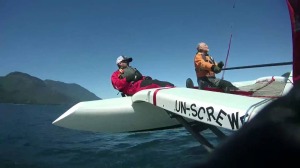 North of the Narrows is snow-capped mountainous wilderness, ice-bound and cold even in June. The Johnstone Strait lead northwest into Queen Charlotte Sound where the full force of the Pacific and Gulf of Alaska hurl onto the Pacific northwest mainland. Here, the racer has a tough choice, at best the steak knives by heading straight up the fearsome Hecate Straights but then cutting inside the Hunter Channel to Shearwater and Bella Bella, both within the relative shelter of the Inside Passage… to the second regulatory waypoint. Or the more conservative minded racing boat, if there are any, can cut to the Inside Passage a little further south, around infamous Cape Caution to enter Fitz Hugh Sound and head through a wide choice of channels that meander north, with only occasional remote boardwalk settlements such as Dawson’s Landing, or perhaps First Nation villages like Klemtu to find sorely needed help. There’s no cellphone or mobile signals here for hundreds of miles. Self sufficiency means survival.
North of the Narrows is snow-capped mountainous wilderness, ice-bound and cold even in June. The Johnstone Strait lead northwest into Queen Charlotte Sound where the full force of the Pacific and Gulf of Alaska hurl onto the Pacific northwest mainland. Here, the racer has a tough choice, at best the steak knives by heading straight up the fearsome Hecate Straights but then cutting inside the Hunter Channel to Shearwater and Bella Bella, both within the relative shelter of the Inside Passage… to the second regulatory waypoint. Or the more conservative minded racing boat, if there are any, can cut to the Inside Passage a little further south, around infamous Cape Caution to enter Fitz Hugh Sound and head through a wide choice of channels that meander north, with only occasional remote boardwalk settlements such as Dawson’s Landing, or perhaps First Nation villages like Klemtu to find sorely needed help. There’s no cellphone or mobile signals here for hundreds of miles. Self sufficiency means survival.
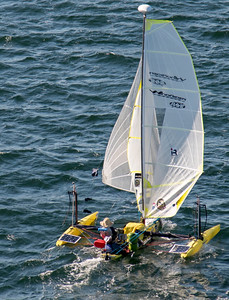 The choice route then is the Tolmie Channel leading to the Princess Royal Channel before entering Fraser Reach and Wright Sound but there’s incredibly scenic narrows and tidal forces all the way. The mountains get higher, the forested shorelines even more dense and there’s old, long abandoned fish canneries such as Butedale, where fatigued racers can choose to tie to rotting log booms surrounded by ruined buildings falling into the sea; there’s also incredibly fresh, cool, clean water tumbling from the falls to wash and replenish much needed supplies. But there’s bears, lots of bears. And countless bald eagles too. Of course, the humpback whales become so numerous that just about everyone quickly forgets to count. Once into the Grenville Channel, racers can take either the Arthur Passage or Telegraph Passage past Port Edward and Prince Rupert into famously temperamental Chatham Sound and the Dixon Entrance – then to the Alaskan border. Thankfully, it’s a relatively short eighty miles distance north to misty, broody Ketchikan, the old gold-rush town born out of declining wealth until the enormous salmon runs brought a new generation of intrepid explorers to Alaska.
The choice route then is the Tolmie Channel leading to the Princess Royal Channel before entering Fraser Reach and Wright Sound but there’s incredibly scenic narrows and tidal forces all the way. The mountains get higher, the forested shorelines even more dense and there’s old, long abandoned fish canneries such as Butedale, where fatigued racers can choose to tie to rotting log booms surrounded by ruined buildings falling into the sea; there’s also incredibly fresh, cool, clean water tumbling from the falls to wash and replenish much needed supplies. But there’s bears, lots of bears. And countless bald eagles too. Of course, the humpback whales become so numerous that just about everyone quickly forgets to count. Once into the Grenville Channel, racers can take either the Arthur Passage or Telegraph Passage past Port Edward and Prince Rupert into famously temperamental Chatham Sound and the Dixon Entrance – then to the Alaskan border. Thankfully, it’s a relatively short eighty miles distance north to misty, broody Ketchikan, the old gold-rush town born out of declining wealth until the enormous salmon runs brought a new generation of intrepid explorers to Alaska.
The 2016 Race North
And so, we ourselves, Marie and I, were there to witness the second annual Race to Alaska as it got underway from Port Townsend, with a brisk 25 knot southerly wind building overnight – sixty one boats contemplating the early morning 0600 start. News of the crazy race for hard-headed sailors, perhaps with a screw loose had spread; the preceding day of pageant, celebration and eager last minute preparation in the warm sunshine drew unexpected crowds and frenzied media attention. Fifty eight boats crossed the start line, three suffering the pain of last minute equipment failure or missing crew ruefully suffering from the alcoholic aftermath of joyous interlude.
 The first short leg, forty plus miles to Victoria, the proving run for twelve months hard work, design, planning and sail racing dreams proved too much for three more boats, which suffered in the high winds that whipped up the Juan De Fuca Strait into a frenzy and then flattened into a sea of flat glass as the early morning wore on. Fifty five of them arrived in Victoria’s busy inside-harbour finish line, with chaos reigning as engineless sailboats of all descriptions contemplated the painfully frustrating lack of wind to bring them in – out came the oars and the home built paddling contraptions that suddenly needed to prove their worth. They came ashore wearily, ritually long-bearded and tired to confront the officious attitude of Canadian Customs, those stoney faced sometimes humourless officials who tried their best but who somehow find it difficult to be human. They have earned themselves a well deserved reputation. This pleads to be the most remembered confrontation,
The first short leg, forty plus miles to Victoria, the proving run for twelve months hard work, design, planning and sail racing dreams proved too much for three more boats, which suffered in the high winds that whipped up the Juan De Fuca Strait into a frenzy and then flattened into a sea of flat glass as the early morning wore on. Fifty five of them arrived in Victoria’s busy inside-harbour finish line, with chaos reigning as engineless sailboats of all descriptions contemplated the painfully frustrating lack of wind to bring them in – out came the oars and the home built paddling contraptions that suddenly needed to prove their worth. They came ashore wearily, ritually long-bearded and tired to confront the officious attitude of Canadian Customs, those stoney faced sometimes humourless officials who tried their best but who somehow find it difficult to be human. They have earned themselves a well deserved reputation. This pleads to be the most remembered confrontation,
“Can you confirm which State your boat was built in?”
“Usually sober but not always. I can’t guarantee to you that I was always sober.”
The first leg to Victoria, the team that got to ring the victors bell was Team Mad Dog. The smoke from the starting gun hadn’t quite cleared when Team Mad Dog’s twin red-hulled greased rocket accelerated downwind into near earth orbit, dodging each and every slower boat to finish in three hours and fifty minutes. Their reward was a congratulatory handshake – and the right to start stage two northwards to Alaska at noon on Sunday, just like every other boat that finished one to fifteen hours later.
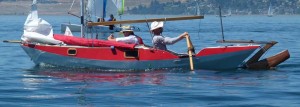 Under the withering gaze of Captain Cook’s bronze statue and the gathering, hugely curious holiday crowds, stage two of the Race to Alaska was given the off by the bell and a borrowed megaphone supplied last minute by the Canadian Government, the crews racing down to the waterline to push their prized crafts out beyond the breakwater. It was a frenzied start, but not for everyone – self-powered Team Kraken Up rushed and hustled just like the rest – then simply made lunch and waited. And the spectacle of the wheelchair bound three man crew of Team Alula propelling themselves unassisted down the steps to jump aboard their F-27 Trimaran to begin this tough hardcore leg of the race made those more able-bodied spectators gasp. These guys quickly endeared themselves into everyone’s hearts. At this time the multitudes of street entertainers, jugglers and singers for which Victoria is famous, joined the throng of the crowds to see what was going off. Then the crews were gone… but not all. The race favourites, the much fancied seventy three foot professionally crewed trimaran Team Tritium Racing simply packed up and went home.
Under the withering gaze of Captain Cook’s bronze statue and the gathering, hugely curious holiday crowds, stage two of the Race to Alaska was given the off by the bell and a borrowed megaphone supplied last minute by the Canadian Government, the crews racing down to the waterline to push their prized crafts out beyond the breakwater. It was a frenzied start, but not for everyone – self-powered Team Kraken Up rushed and hustled just like the rest – then simply made lunch and waited. And the spectacle of the wheelchair bound three man crew of Team Alula propelling themselves unassisted down the steps to jump aboard their F-27 Trimaran to begin this tough hardcore leg of the race made those more able-bodied spectators gasp. These guys quickly endeared themselves into everyone’s hearts. At this time the multitudes of street entertainers, jugglers and singers for which Victoria is famous, joined the throng of the crowds to see what was going off. Then the crews were gone… but not all. The race favourites, the much fancied seventy three foot professionally crewed trimaran Team Tritium Racing simply packed up and went home.
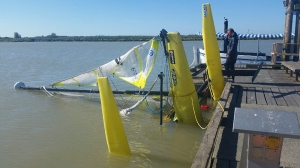 Heartbreak
Heartbreak
By day three of the second leg a total of eleven teams had withdrawn for one reason or another; broken rudders, broken masts and broken bodies being the prime reason. Heart searchingly, the single paddle-board entrant, who’d been leading even some of the fast multi-hulls at one point, called it a day when exhaustion finally set in. Karl Kruger paddling and sailing Heart of Gold had calculated his daily calorie requirement to three thousand calories which he took into his body only through dehydrated food pellets, which he would chew at thirty five calories apiece at twenty minutes each – he’d done the maths and trained for a whole year, calculating weight and how fast he could travel against how many calories he could survive on. Alas, his paddle-board and one side of his body began to give way, to the point that a one-way circular route wouldn’t get him to the magical tree in time and he reasoned that steak knives were of no use when consuming pellets. Kruger broke the hearts of almost everyone when he called it a day. In the meantime, Team Mad Dog’s catamaran was ahead… but swiftly being caught by their deadly rivals, the trimarans of Team Mail Order Bride, the F85SR Farrier Super Racer and the big, tall, blond Norwegians brothers of Team Big Broderna in their F31R – although the carbon fibre monohull of Team Jungle Kitty was beginning to power through the field. The Race to Alaska was now on.
 Then came the first grizzly bear attack. The facts are still hazy – shock is never an easy emotion to describe in sensible detail. It seems the two man crew of Team Wabi Sabi, a Drascombe Longboat, went ashore to, well, you know, rid themselves of bodily waste in the privacy of the dense forest. A grizzly mother and her cub happened to take offence at the sight of man in the act of squatting in the time honoured fashion and decided to charge in what turned out to be an inopportune moment for both man and bear. Needless to say, the scrambled dash and headlong panic followed by a hurried boat launch only just kept Team Wabi Sabi in the race, with trousers raised once the safety of their rowboat had been gained and sufficient sea room to relax. Contemplating their extremely lucky escape, they turned to see the bear prowling close by on the shoreline with a strange stain upon its snout.
Then came the first grizzly bear attack. The facts are still hazy – shock is never an easy emotion to describe in sensible detail. It seems the two man crew of Team Wabi Sabi, a Drascombe Longboat, went ashore to, well, you know, rid themselves of bodily waste in the privacy of the dense forest. A grizzly mother and her cub happened to take offence at the sight of man in the act of squatting in the time honoured fashion and decided to charge in what turned out to be an inopportune moment for both man and bear. Needless to say, the scrambled dash and headlong panic followed by a hurried boat launch only just kept Team Wabi Sabi in the race, with trousers raised once the safety of their rowboat had been gained and sufficient sea room to relax. Contemplating their extremely lucky escape, they turned to see the bear prowling close by on the shoreline with a strange stain upon its snout.
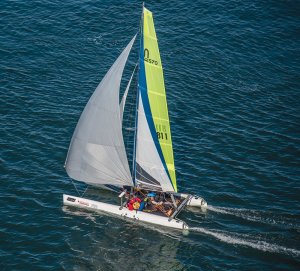 Team Mad Dog won the 2016 Race to Alaska. They arrived in Ketchikan in their M32 catamaran in three days, twenty hours and thirteen minutes to ring the bell and unpin the nailed-on ten-grand from the tree. They were followed by Team Jungle Kitty, the carbon fibre Fox 44 monohull with a crew of eight, who claimed the ten dollar set of steak knives. But you must not leave this tale yet, not without knowing the story of the real winners of the Race to Alaska, the heart rendering story of the three wheelchair bound crew of Team Alula. They’d not mentioned to any of the race organisers at any stage that they were disabled, Team Alula themselves said the question never raised its head and it never occurred to them to explain. Thousands of spectators, the frenzied press, the organisers and we ourselves took Team Alula into our hearts. Losing one member of their crew, exhausted and in extreme pain in Port Cambell, they vowed to carry on, sharing the impossible task of tackling the very real perils of the Seymour Narrows between the two of them. Spectators rallied, many wept in frustration and sorrow. News of the predicament of Team Alula reached the race crews of boats already finished, with crew members Morgan Tedrow of Team Mail Order Bride and Mark Eastham of Team Ain’t Brain Surgery hurrying swiftly back from Ketchikan to assist.
Team Mad Dog won the 2016 Race to Alaska. They arrived in Ketchikan in their M32 catamaran in three days, twenty hours and thirteen minutes to ring the bell and unpin the nailed-on ten-grand from the tree. They were followed by Team Jungle Kitty, the carbon fibre Fox 44 monohull with a crew of eight, who claimed the ten dollar set of steak knives. But you must not leave this tale yet, not without knowing the story of the real winners of the Race to Alaska, the heart rendering story of the three wheelchair bound crew of Team Alula. They’d not mentioned to any of the race organisers at any stage that they were disabled, Team Alula themselves said the question never raised its head and it never occurred to them to explain. Thousands of spectators, the frenzied press, the organisers and we ourselves took Team Alula into our hearts. Losing one member of their crew, exhausted and in extreme pain in Port Cambell, they vowed to carry on, sharing the impossible task of tackling the very real perils of the Seymour Narrows between the two of them. Spectators rallied, many wept in frustration and sorrow. News of the predicament of Team Alula reached the race crews of boats already finished, with crew members Morgan Tedrow of Team Mail Order Bride and Mark Eastham of Team Ain’t Brain Surgery hurrying swiftly back from Ketchikan to assist.
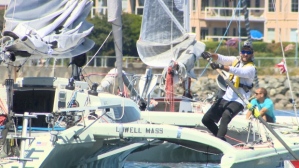 Of course, this outside assistance meant instant disqualification under the R2AK rules but, what the hell, there are no rules. Team Alula vowed to carry on even though disqualified and still many miles south of Ketchikan. The improvised crew of now four, with original crew skipper Spike and his exceptionally good friend Zach, powered on and made Ketchikan in their F-27 trimaran on day sixteen with Zach, who’d never sailed in his life until three months before the race, emotionally at the helm. Waiting on the finish line, in total surprise, were his tearful mother and sister. These two incredible racers were carried, chairless, over the emotional, wildly cheering heads of countless thousands of racers, organisers, press and spectators to ring the finishing bell.
Of course, this outside assistance meant instant disqualification under the R2AK rules but, what the hell, there are no rules. Team Alula vowed to carry on even though disqualified and still many miles south of Ketchikan. The improvised crew of now four, with original crew skipper Spike and his exceptionally good friend Zach, powered on and made Ketchikan in their F-27 trimaran on day sixteen with Zach, who’d never sailed in his life until three months before the race, emotionally at the helm. Waiting on the finish line, in total surprise, were his tearful mother and sister. These two incredible racers were carried, chairless, over the emotional, wildly cheering heads of countless thousands of racers, organisers, press and spectators to ring the finishing bell.
This, above all else, encompasses the true grit spirit, the philosophy and deep understanding of human nature that has created the greatest and, perhaps, one of the toughest sailing races the world has yet seen.
Dave & Marie Ungless are currently sailing their boat Sänna around the world from west to east. Their eleven year voyage so far has taken them into the North Pacific and to Alaska where they are now located. Dave is a freelance writer and journalist writing about their travels and the social aspects of their journey.
You can view their sailing website at www.sanna-uk.com and their sailing blog at www.sailblogs.com/member/eastwards.
You can also Like their Facebook page at www.facebook.com/sv.sanna.
Please visit the official Race To Alaska (R2AK) website for more information.

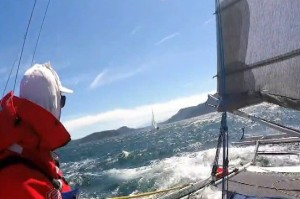




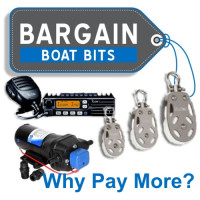
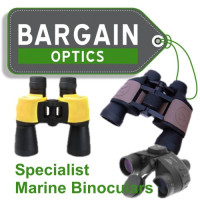
Remember…the night racing is relatively easy because the nights are short, the days long. Maybe only three hours of truly dark night, and even then, it is only nautical and astronomical twilight, so, not so bad!
LikeLike
It is spelled “Strait”! and single, no plural. Unless you are going to Haro and Georgia Straits, both. I love it! Here’s my article. threesheetsnw.com/blog/2016/07/why-i-love-the-race-to-alaska/
LikeLike
Thanks Shannon, I’ll make the spelling changes, it’s either my infuriating iPad spell checker or me not proof reading properly. I originally checked the names on my charts because I’m not a local – there are so many different naming protocols around.
LikeLike
Come on Dave, couldn’t be that Brit big head could it? Fantastic R2AK sidebar blog by Shannon – KUDOS – I don’t know why anyone would not stay in the PNW and enjoy this slice of heaven.
LikeLike
Could be. The blog article is driving huge amounts of visitor traffic tho. The article was originally scheduled to be published in one of the UK’s sailing magazines but Time.Inc have halved their freelancer fees due to financial cutbacks. Something to do with the Internet apparantly.
LikeLike
Dave, so glad to see you back in Alaska with Marie’s son visiting from the UK, maybe he will return and say he wants to go through the NW Passage on SANNA and finally receive permission – few landlubbers have any understanding of what is taught and learned by going to sea… I wish more could go because many Milleniums could definitely use some salting up characterization. Yes, I’m sure Cowper would give any of the R2AK bunch a run for their money – after breaking sailing (i.e. in a sailboat) circumnavigation records both to the east then turned around to the west is fantastic that he is again breaking records at age 74 – TODAY he has transit Labrador Channel west in Fury & Hecla Strait – first yacht since discover 194 years ago – speaks volumes to his seamanship. Sail on!
LikeLike
R2AK gets my attention but not until the most recent NW Passage attempt that I’m supporting by David Scott Cowper on M/V POLAR BOUND from Greenland via Fury & Hecla Strait known as a NW Passage Route-7 West – the distances involved, the horrendous storm seas weather stacking waves against 7m tide flows has required laying to hull several times – just to much to take for the crew and 14m custom expedition motor vessel. I even learned a new term for extreme tide rips called “Swirlers” off Topsail Head on Resolution Island in Hudson Strait that extended for more than 2 miles – the crew said it was like being in an 18 foot sea that couldn’t find its way out of a washing machine – it literally beat them black & blue. Since entering Hudson Strait the tidal currents have never stopped with 2 to 7 knots of current as they have worked their way some 700 plus nautical miles up Hudson Strait and Foxe Basin towards Fury & Hecla Strait through 50-70 knot winds – and to make matters more stressful they have repeatedly lost sight of the bow in heavy fogs. Stressful voyage – I can’t imagine worse. So when someone tells me R2AK is the hardest race I might say OK but have any of them done a Route-7 Northwest Passage? It appears POLAR BOUND will be the first since F&H Strait was discovered by Commander William Parry in 1822. My hat goes off to all of the Arctic explorers and crews – especially those who endured wintering over for multiple years like McClure and crew on HMS INVESTIGATOR who discovered what we call today a Route-1, it is the original route of the Northwest Passage, spending five years searching for the 129 man lost Franklin Expedition who perished to never returned home. McClure and crew were rescued by HMS Resolute but not before abandoning her also beset in sea ice and walking over frozen sea ice some 300 miles east to Beechey Island being fortunate to find HMS NORTH STAR at anchor for a ride home to England. That is what I call the first and hardest voyage in the world taking five years to circumnavigate the Americas through the Arctic Northwest Passage sea ice. Fast forward to 2016 – R2AK – yabetcha its a modern day challenge but the log books of Arctic explorers records another kind of race – to return home to family, friends and country after a long voyage might be the greatest race of them all.
LikeLike
Yes, David Scott Cowper is a living legend in the UK and I’ve talked with him a number of times. We also bumped into him in New Zealand when he was heading north across the Pacific in 2011 for the northwest passage. Polar Bound is a motor vessel of some note and not a sailing vessel… there cannot be any comparison with the small sailboats that sail the 750 miles through BC. Of course, David himself would be well capable of competing in the R2AK but few others would Douglas and perhaps you do the R2AK racers a disservice, especially to crews such as Team Alula who’s remarkable achievements were no less than many other long distance endurance sailors… and certainly more than those boaters who rarely leave harbour.
LikeLike
12.49m sloop OCEAN BOUND twice circumnavigation by DSC beating both Chichester’s and Blyth’s records then goes on in a converted lifeboat named MABEL E. HOLLAND and finally a 14.6m custom motor vessel named POLAR BOUND tells me it has very little to do with the type of vessel but more about the person you have seemed to overlook saying boat boat boat. I say person person person. Yesterday, DSC set another world record with a transit of Labrador Narrows in Fury & Hecla Strait closing Northwest Passage Route 7 westbound – the first Route 7 by yacht since the discovery of F&H Strait by William Parry 194 years ago in 1822. The boat – just a tool used by an exceptional individual in pursuit of a special goal – in DSC’s case, his fascination to follow in the footsteps of ancient mariners such as Cook, McClure, Amundsen, Bellot and Parry. Details posted online at: http://arcticnorthwestpassage.blogspot.com/2016/08/new-northwest-passage-record-closes.html?view=flipcard
LikeLike
Was only thinking about you the other day bumped into Sue – hope all is well
Sent from my iPhone
LikeLike